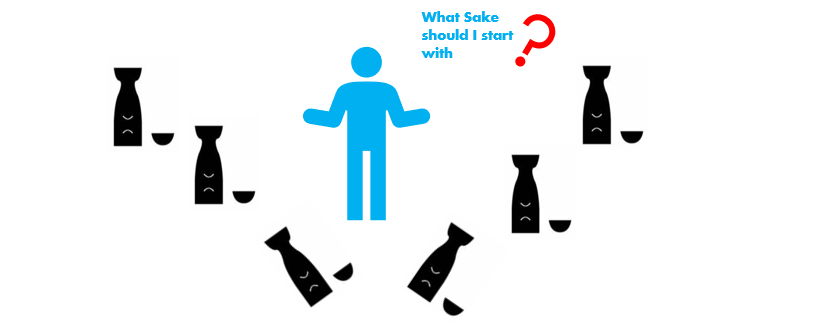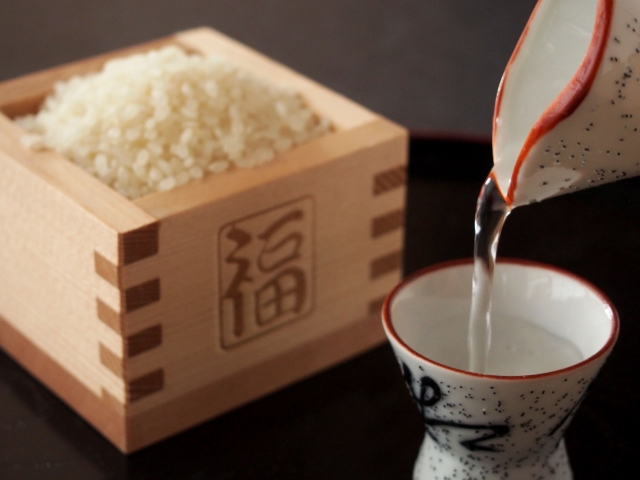Sake,which is originated from the same root of Japanese national food, rice, has become a new symbol of Japanese culture recognized by people worldwide. With the development of past 2000 years, Japanese Sake finally starts to walk into the world and enters into everyone’s life, nowadays, it’s not rare to find Sake from a five-star hotel in America, as well as a Japanese restaurant in Australia. However, Sake, being served as a normal drink in Japan, in most foreign people’s eyes, is still very mysterious. In this article, we will unveil the mystery of Sake and provide some basic Sake knowledge for you.
I believe before wine got popular around the world people’s first question on it is what is wine? To solve this doubt that you may also have on Sake, here in the first part of the article, we will give you a brief introduction on Sake.
In Japan, people call Sake Nihonshu. It can be also called as Japanese rice wine, it’s a kind of alcoholic beverage made from fermented rice which has been polished to a certain point of rate. The main ingredients to make Sake are quality of Sake rice, water, koji and yeast. The brew process for Sake is different from beer and wine, where the conversion from starch to sugar and then from sugar to alcohol occurs in two distinct steps. For Sake, it’s a sophisticated production method called parallel fermentation that combines the processes of saccharization and fermentation, which is the alcoholic content between 16%~20%.
Below is an average alcohol content chart of different alcohol.

Many new kinds of Sake have been made during the past 100 years with the development of sake making technology. Based on different criteria, Sake can be mainly classified as below:
Classify from the degree of polishing
Rice grain needs to be polished before using as Sake rice, generally speaking, the more polished the rice is, the premium the Sake will become. The polish is to remove the outer layers of the grain, which contains an abundance of vitamins, fats, and protein. It is especially important to reduce protein, because during fermentation, protein breaks down into amino acids that can taste bitter. More polishing results in lighter, cleaner tasting Sake.
For premium Sake, normally polish rate is around 40%. Below are two kinds of primary premium Sake. (Polish rate = the percentage of remaining rice)
Ginjo, at least 40% of the grain has been polished away.
Daiginjo, at least 50% of the grain has been polished away.
Classify from the addition of alcohol
In order to reduce the process time of the Sake and increase the Sake shelf-life, sometimes, brewers choose to have a little added, distilled alcohol (often listed as “brewers’ alcohol” on the bottle) in the Sake. This will not only help to stabilize the Sake quality but also increase Sake’s taste and aroma differently based on the alcohol been added into. Under this criterion, there are mainly below 2 kinds of Sake.
Junmai, no alcohol has been added to the Sake.
Honjozo, a small amount has been added to fasten the speed of Sake brewery as well as improve the flavor.
Besides above, there are other popular Sake as well. Their making process as well as taste are more special due to the specific brewer process. Here is the introduction.
- Nigori Sake, was first invented by Brewer Tokubee Masuda, of Kyoto-based Tsukino Katsura brewery, founded in 1675. From 1964 (or 1966), Masuda began to produce an unfiltered Sake that would be cloudy and offer a visual component, similar to European wines. Unlike other Sake, Nigori Sake is only coarsely filtered, resulting some of the rice solids left over from fermentation, it’s effervescent, unpasteurized, and slightly sweeter, around 12-17% alcohol by volume. Nigori Sake has a very milky and creaminess flavor, and is sweeter than other Sake. It’s one of the specialties among the Sake world.
- Amazake, is a traditional sweet, low-alcohol Japanesedrink made from fermented rice. It’s a low or non-alcohol beverage, similar to Nigori Sake, it has the cloudy color and normally very thick. Amazake can be used as a dessert, snack, baby food, salad dressing or smoothie.
- Sparkling Sake, is very popular these days. Similar to sparkling wine and Champagne, Sparkling Sake is a kind of Sake with effervescent quality. The goal of sparkling Sake is that it only uses fermentation instead of artificial carbonation to keep the carbon dioxide within the Sake. This can be done in the tank during the Sake production process or by adding an active yeast, known as kassei nigori, when the Sake is bottled. The active yeast will produce a sparkling Sake that gets more and more effervescent as time goes by. However, the alcohol percentage in the sparkling Sake is not as high as the normal Nihonsyu, it is normally around 5-10%.
- Kosyu (aged Sake), is defined by long-term matured Sake research association, as [Sake (excluding sugar-added Sake) that has been aged in Sake brewery for more than 3 years]. However, it is not a strict official definition, what we know is just that Sake changes a lot by aging. Aged Sake tastes so different from regular ones, and even among aged Sakes, tastes change according to different aging methods, such as the category that is chosen to age, the aging temperature, and the aging time. After the Sake has been aged, the taste of Sake will also be changed. Aroma turns milder, and some smell like coffee or roasted caramel. Color turns to be golden like an amber. Some people say that it tastes a kind of like whisky, and some whisky drinkers enjoy aged Sake very much. Because aged Sake tastes strong, it is highly recommended that aged Sake can be used to cook Sake ice cream.
- Namazake (Raw Sake), is pasteurized twice in the Sake brewing process. One is after filtering and the other is after diluting. On the other hand, Namazake is pasteurized only once or even none, being fresher Sake. Namazake is usually quite noticeably different from pasteurized Sake. It is young and brash, with contrasting flavors and sharper edges, much like a young wine. Often the fragrance is much livelier and more apparent, and there is an unmistakable liveliness and freshness to the Sake overall. A half year or so of aging would mellow these edges out, and tie the various flavor components together, but young Namazake has its own special appeal.
Above is a roughly introduction of different kinds of Sake (Nihonsyu), we can learn that the producing process and ingredient varies within different Sake. As mentioned earlier, Sake has started walking into the world and showing up in many high-level hotels or restaurants. A report posed in 2018 states that the Japanese Sake exportation has been at a record high for the last 8 years, and America remains the primary export partner. But what can make people except Japan start to love Sake, and what are the differences between Sake and other alcohol beverage?
The main ingredient for Sake is rice, and Japan is the country of rice. Rice can be divided into mainly 2 kinds here in Japan; One for food use while the other one for Sake specific use. The special Sake rice only exists in Japan makes Sake taste richer and original. This is the key factor makes Sake special than other alcohol or Sake made in other countries. The original Sake made in Japan is famous for its taste of Umami and Kokumi, which has been called as the fifth and sixth taste existed except sweet, salty, sour, bitter.

Umami is a loanword from the Japanese (うま味), umami can be translated as “pleasant savory taste”. This neologism was coined in 1908 by Japanese chemist Kikunae Ikeda from a nominalization of umai (うまい) “delicious”. The compound 旨味 (with mi (味) “taste”) is used for a more general sense of a food as delicious. Kokumi was a more recent discovery also by the work of Japanese researchers in 1989. It was found that the addition of a pure, tasteless water extract of garlic evoked the kokumi sensation in a dilute solution of glutamate and inosinate.
Both umami and kokumi taste sensations are activated by amino acids or small peptides. Researchers postulate that umami and kokumi are evolutionary sensations that point to the presence of proteins and amino acids in a food, much like sweet is an indicator for carbohydrates, sour for acids, salts for minerals, and bitter for poisons. Umami flavor is strongly associated with the presence of the amino acids’ glutamic acid and aspartic acid. The extract alone possessed no flavor at the concentration threshold used, however, the addition of the two synergistic umami components brought out a noticeable garlic flavor to the extract with the characteristic mouthfulness associated with kokumi. That is to say, Umami means the savoriness, Kokumi means the richness and deliciousness of the food and drink.

With such a compatible rich and delicious flavor, Sake can pair well with most of the food and dishes. The birth of Sake in Japan proves that the match between Sake and Japanese cuisine is the perfect. That is why you can see there are always Sake available in Japanese restaurant. The fresh Japanese sashimi, and sushi are no doubt the best partner of Sake. However, Sake can also pair well with other food rather than Japanese cuisine. Taking Nigori Sake for example, it can pair well with spicy food, as the milky texture and creaminess can reduce the strong sensation of the spiciness and improve the food taste. Namazake, with the fresh and fruity flavor, can pair well with heavy dish, such as fried dish or creamy dish. Sparkling Sake, which has caused a boom in Japan market in recently years, is famous for pairing with juicy, crisp fruit salad. You can choose the fruit like apples, pears, grapes, melon, and strawberries in your bowl or design it based on your personal likes, topping it with yogurt or honey. Sparkling sake will also give you a different fruit salad enjoyment. The fizziness will ease the weight of the yogurt, while the fruity, subtly sweet palate will aid to enhance the flavors of the fruit.
Above are just some common pairing suggestions for Sake. There are no absolute pairing rules since people’s tastes are different and the richness of Sake flavor is different as well. You will have to try different Sake on your own, and we are sure that you will find one kind of Sake you could fall in love with definitely.
But probably you will ask, there are so many kinds of Sake and how could I know which one I should start with? Well, don’t worry, we’ve thought about that. In the next part, we’ll give you some recommendations.

There are actually two categories of Sake in Japan: 1. tokutei-meisho-shu, which literally means specially designated Sake. 2. futsu-shu, which literally means non-premium Sake. Some of the Sake we talked about above are Junmai, Ginjo, Honjozo, which are all categorized as tokutei-meisho-shu. Brewers have to follow certain guidelines when making tokutei-meisho-shu to ensure a higher quality product. Futsu-shu is Sake that has not been made up to tokutei-meisho-shu standards and contains more additives and distilled alcohol than tokutei-meisho-shu as well. You will find that a lot of cheap restaurants and izakaya serve cheap futsu-shu in Japan.
For beginner who doesn’t know the taste of Sake, it’s better to start with premium Sake with strong Sake aroma and taste, such as Ginjo, (only 8% to 9% of all Sake brewed is Ginjo grade), with at least 40% polish rate, or Junmai Daiginjo, which is regarded as the highest-grade Sake. The best products in this class deliver a good blend of refined taste with acidity and umami.
Another reason why we suggest Ginjo is going well with wine glass. You don’t need to be worried about that the Sake from Japan must be drank in a Sake cap called Ochoko. When served slightly chilled in a wine glass, it can delight the novice drinker to feel more taste such as fruits or flowers aroma in the Sake. Ginjo is the one which is easy to let Sake beginner appreciate Sake and also not too strong for a start.
Maybe you’ll ask, why should we enjoy Sake in wine glass? Sake and wine are so different, will wine glass work fine for Sake? The answer is totally yes, I guess the knowledge you have before tells you that Sake should drink only with Japanese Sake cup. But in our recent interview with the American Sake expert Gordon Heady, who has lived in Japan for over ten years, he suggested us to learn to enjoy Sake in wine glass. His reasons for choosing wine glasses over the traditional Ochoko or cup is because the wine glass allows the complex aroma of Sake to unfold fully. This is a nice thing for wine drinker because you don’t need to buy a Sake cup on purpose in order to drink it. A wine cup will be good enough.
So far, we talked about the basic information of Sake, to make you better understand the difference /characteristics of Sake, let’s have a comparison between wine and Sake.

The biggest difference in taste comes from the actual raw ingredient used in creating these drinks. Wine uses grapes as its main ingredient, and Japanese Sake mainly uses rice. Especially in their sweetness, contrary to what many people believe, Japanese Sake is sweeter than wine. And as such, Sake also has more calories than wine. A glass of Sake of 100 grams contains 103 calories whereas wine has about 83 calories for the same amount.
Sake is not put under controlled temperature like wine which is stored in cellars. The name of different types of Sake will also differ depending on the way it’s been drunk. There are more ways to enjoy Sake than drinking wine depending on different seasons with different temperatures. In the spring and fall, Sake is traditionally drunk in room temperature. In the summer, Sake is prepared as “Reishu”, or refrigerated Sake. While chilled Sake is the way to go in the summer, heated or warm Sake “Atsukan” is enjoyed in the winter.
Compared to wine, the special drinking way and the aroma of Sake may attract your taste buds and open a new experience for you. As an alcohol drink, Sake has been identified as less harmful and can generate good benefit to our body when we drink in moderation. The rich amino acid included in it will help improve our body immune system to some extent, and we will give you an introduction on this in another article. However, if you drink too much it will only generate bad rather than good. So, it is really important to enjoy Sake in a relaxed with a self-controlled spirit.
Reference link
- https://en.wikipedia.org/wiki/Sake
- https://www.masumi.co.jp/english/spirit/process1/
- https://en.wikipedia.org/wiki/Nigori
- https://matcha-jp.com/en/7420#:~:text
- https://kyotoSakeexperience.com/
- https://www.japan-guide.com/e/e2037_Sake.html
- https://www.Sake-talk.com/what-is-nama-Sake/
- https://Sakeworld.wordpress.com/
- https://www.alcoholprofessor.com/blog-posts/blog/2017/12/11/sparkling-Sake-pairings-for-bubbly-lovers
- http://Saketips.love/Sake101_ep005_en/
- http://www.japanSake.or.jp/Sake/english/howto/type.html
